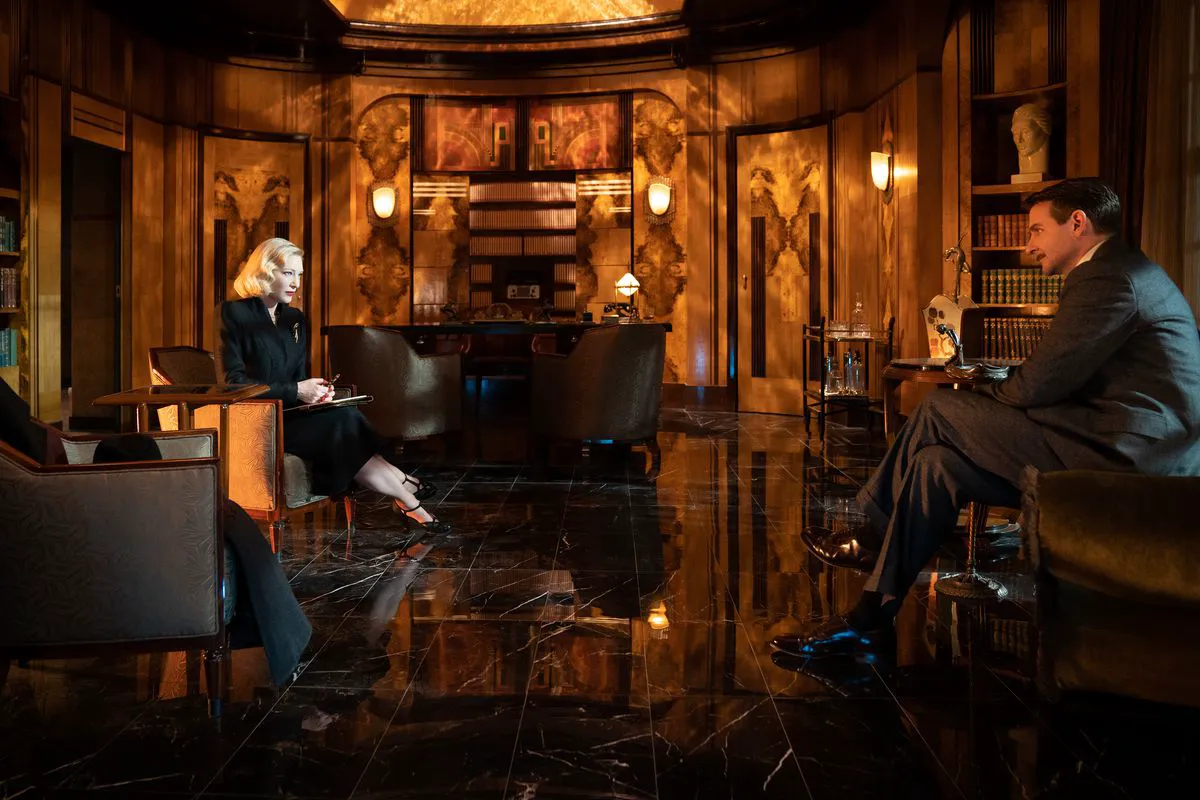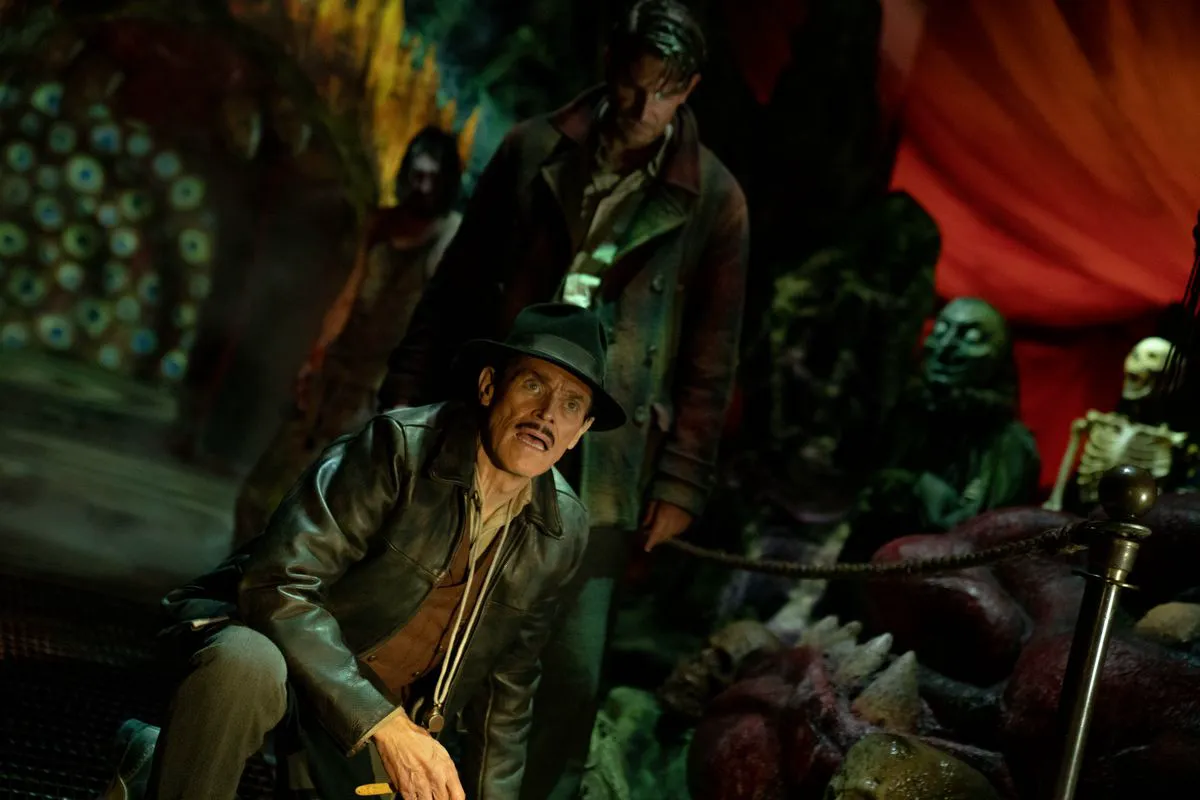Nightmare Alley: A Dark Descent into Deception and Art
A young man named Stan Carlisle (Bradley Cooper), fleeing from an ambiguous past, embarks on a journey across America, eventually stumbling upon a traveling carnival. Intrigued by its performers, he decides to stay and learn the tricks of the trade from a fortune teller named Zeena (Toni Collette). Zeena pretends to read minds, but in reality, she and her alcoholic husband are skilled at deceiving their audience. Stan discovers that the couple once had a successful act where they accurately guessed objects held by audience members using a cleverly constructed code. After mastering this technique of mentalism, Stan plans to leave the seedy carnival and start a solo career, taking the charming Molly (Rooney Mara), a woman who withstands electric shocks on stage, with him.

Bradley Cooper as Stan in “Nightmare Alley”
“Nightmare Alley” is an atypical film for director Guillermo del Toro in many ways. If you were expecting mysticism, monsters, and curses, you’ll find a stylish homage to classic film noir. Instead of another radical critique of the American dream, Nazism, or conservatism, del Toro engages the audience in a discussion about the artist’s purpose and moral responsibility to the public. Del Toro expands the runtime to 2.5 hours, and the dynamic multi-genre approach of “The Shape of Water” is replaced by a deliberate restraint, characteristic of truly great directors.
Del Toro’s Personal Reflection
Yet, this is still the del Toro we admire, just more deliberate and somber. This film holds special significance for him; it reflects his own experiences and the world that surrounds him (and any artist) daily, making it perhaps his most personal work. Stan enters the carnival as an inexperienced novice, but soon the tents, shimmering lights, and carnival melodies envelop him, transforming his life into a grand industrial fairytale. Carlisle and his colleagues are not just wandering performers; they are artists, creators whose imagination rivals that of a painter or actor. Stan constantly carries a sketchbook, sketching new attractions, and his oratory skills save him from failed performances and mundane situations.

Cate Blanchett as Lilith Ritter in “Nightmare Alley”
Beneath the stylish baroque visuals, nods to classic noir, and Bradley Cooper’s slicked-back hair lies the film’s true purpose. The charming Stan, who evolves from a penniless nobody to a stage master and back again, is an alter ego (or at least an anti-example) of del Toro himself. What truly differentiates carnival life from cinema, and showmen from Hollywood stars? Carlisle, burdened by his talent, and Zeena, the clairvoyant, are the most gifted of the carnival’s inhabitants. Their deception has a healing, almost therapeutic quality: tell people that their deceased loved ones are nearby, and a happy smile immediately spreads across their faces. However, for del Toro, there is always a line in cinema, as in any skillful fiction. Artists are obligated to lie by nature, but they must never exploit the emotions of the public.
The Illusion of Life and Art
“Nightmare Alley,” whether in William Lindsay Gresham’s original novel, the 1947 adaptation, or this new version, tells a story about the deceptive nature of life and art. The philosophy of Tarot cards intertwines with psychotherapy, and the carnival’s daily life cleverly mirrors the complexities of high society. Everything in this story is, on one hand, predetermined, and on the other, never fully understood. The film resembles a card trick – an obvious deception that leaves more questions than answers. You experience a childlike delight in recognizing the illusion, yet you want to get to the heart of it: in this case, the essence of human psychology. Although the characters in “Nightmare Alley” are perhaps the most verbose in del Toro’s filmography (at one point, Bradley Cooper even lies on a Freudian couch and talks about his troubled childhood), the key to their actions must be found like the villain in “The Devil’s Backbone”: meticulously, fruitlessly, and without support.

Willem Dafoe in “Nightmare Alley”
The Dark Side of Artistic Manipulation
Towards the finale, reflections on the sinister power of art and the complexities of human nature merge. The setting of “Nightmare Alley” is 1941. As Stan grapples with his life, news of World War II reaches him through the radio, newspapers, and conversations. Guillermo del Toro has always been intolerant of Nazi ideology, but here he allows his hatred to take a back seat. The discussions about Hitler, the conquest of Europe, and bloody battles are not for historical setting but for the same dialogue about the artist. Nazi Germany is a product of propaganda, cultural manipulation, and deception. Outstanding but misguided geniuses (Leni Riefenstahl), like Stan, turn their gift against humanity.
That’s why “Nightmare Alley” is del Toro’s most pessimistic film. If in “The Shape of Water” the characters could communicate through art, here it separates Stan from the world. His favorite authorial trick (making monsters human and humans monsters) seems to come full circle. Bradley Cooper’s character, like other white cisgender men in the author’s filmography, bleeds, slowly decomposes, and turns into a monster. The director will be criticized for self-repetition, predictability, and slowness – the latter is noticeable in the monumentally long “Nightmare Alley” when the film passes the equator. On the other hand, if every director made films as “boring” as del Toro, the world would be much happier. The main thing is not to get lost in the labyrinths of Fauns and not turn into a beast, like Stan – the director’s decorations and costumes can distract from the most obvious and important subtexts.